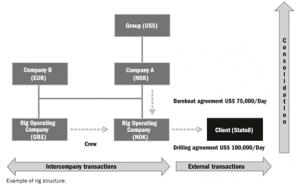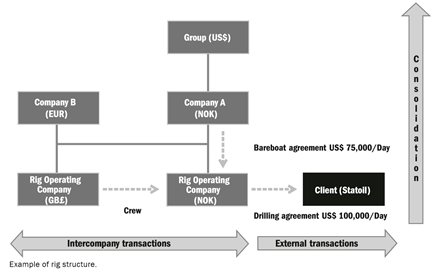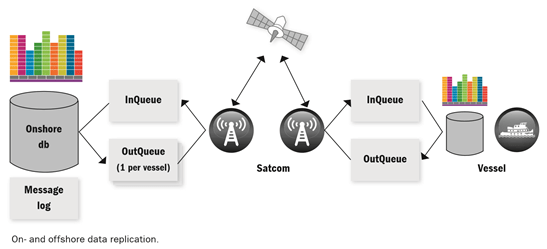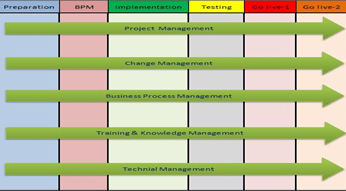Fundamental changes are happening in the global drilling industry. In the midst of an unprecedented capital investment boom, the global drilling industry is undergoing significant structural change as well as a fundamental shift in requirements for operational performance. International drilling contractors face a situation in which strong growth requires new ways of handling increased pressure on human resources, equipment utilization, and asset performance. This growth coincides with rapidly evolving legislative and political environments in which the “license to operate” puts procedures, systems, visibility, and traceability to the test.
Drilling contractors are continuously exposed to regulatory (e.g. Brazil Nota Fiscal) and commercial changes (e.g. pricing/rates) together with frequent alterations of customer demands. In fact, the industry is affected by operational, financial, and regulatory processes that are far more complex than in any other industries. Consequently, companies that strive to be successful in this project- and contract oriented business must be able to quickly recognize and act upon industry changes and changes within on-going projects and contracts.
For most contractors, long-term assets management and maintenance still remains the number one priority. Asset upgrades or lifecycle extensions on drilling rigs or production platforms are met with strict quality requirements. Unwarranted downtime directly affects the bottom line and must be avoided via all means. To secure an optimized asset management process, several key functions must be in place: (i) a well-functioning logistics operation in which spare parts and plans for execution must be secured; (ii) full visibility, whereby complete offshore and onshore replication of data is essential; and (iii) traceability across all varying layers.
Information technology can certainly play a major role in fulfilling the above challenges. Unfortunately, many drilling contractors still struggle with fragmented business solutions with several varying, non-integrated, proprietary IT systems that result in poor information flow; inaccurate, cumbersome data retrieval; and reduced decision-making capability.
This white paper looks at several factors to consider when looking for an ERP system and emphasizes areas of particular importance. Its overall aim is to describe what you must consider and account for when selecting a solution that will ultimately enable organizational responsiveness and optimization of your processes.
VISIBILITY & TRACEABILITY IN THE VALUE CHAIN
Full visibility and traceability of the complete equipment and material lifecycle is crucial in the oil and gas industry. All material transactions and completed equipment documentation from “as designed” to “as installed” must be accounted for.
Regardless of where a piece of equipment, system or component is used, you must always be able to trace it back to the relevant (i) requisition, purchase, or shop order; (ii) project, supplier, or stock number; and (iii) receipt or certificate. It must be convenient to search for relevant data, and you need a high level of confidence that information is secure and accurate.
But today’s industry still struggles with fragmented business solutions that lack integration; this makes it difficult to produce a comprehensive asset lifecycle view. In your current operations, you probably face these and other issues:
- Extensive data silos
- Poor quality data in information systems; limited value for operational teams
- Difficulties in gathering information; poor visibility across the value chain (i.e. projects, purchase, operations)
- Difficulties in using frame agreements
- Non-integrated cost management; mostly done in Excel (except recording of actual and committed costs that are stored in the financial database)
- Incomplete decision support; consolidating reporting is cumbersome
Needless to say, this produces several inefficiencies for operations (in decision-making) and for financial budgeting and control. But with a strategic ERP approach, you can eliminate these inefficiencies. How? By enabling an integrated ERP system that can connect your business processes onshore and offshore and between rigs and sites.
When facilitating information flow across varying disciplines, you will increase efficiency and get full visibility and traceability of equipment, material, and people in the operations.
FINANCIAL MANAGEMENT & CONTROL
Use of non-integrated and fragmented systems is time consuming. Getting the overall financial picture is cumbersome—and even more complex for drilling companies that operate globally with varying regulations and tax regimes. One critical success factor for offshore service companies is the ability to financially track asset transactions such as movements of rigs between asset owners and contract or operating companies, yard stays, and modification jobs. At the same time, the accounting department must perform daily financial activities.
 The ERP solution should support:
The ERP solution should support:
- One common solution for asset, logistics, contract, projects, and finance—to secure traceability and visibility throughout the lifecycle of the asset/rig and to be able to trace and monitor total cost of ownership
- High data quality, which minimizes risk for errors and manual handling and facilitates follow-up
- Regulatory compliance in a global environment, such as Nota Fiscal in Brazil, local GAAP versus IFRS and US GAAP
- Complex rig and corporate structure
- Improved performance management based on real-time data
- Traditional accounting such as invoicing and payment; supplier invoice workflow; currency calculations and adjustments; budgeting and forecasting; and fixed assets and project accounting
PROJECTS AT THE CORE OF THE BUSINESS
For most drilling contractors, projects are the very cornerstone of the business. Therefore, capability to efficiently manage projects of various sizes and complexity is crucial for staying competitive. But a common obstacle is how projects are being organized and supported. Traditional organizational structures and systems normally make it difficult to understand real-time operational situations, which delays corrections to resourcing and supply. The delays are expensive and almost make it impossible to determine whether or not an opportunity will ultimately be profitable.
Instead, structuring a business around a network of integrated projects—rather than fixed departmental or geographic silos—is fundamental for success within projects and on an overall basis. This can be achieved via a truly holistic ERP system that enables companies to move from being departmentally constrained to truly embracing end-to-end processes. In addition, this (i) gives managers better progress visibility, (ii) enables efficient risk management, and (ii) allows for instant adjustments.
New Builds & Modifications
Drilling companies that order new drilling rigs, or must modify critical equipment, typically organize these new buildings or modifications as projects. Why? Plain and simple: to facilitate execution as per cost, progress, and delivery time. To track complex projects, it is necessary to establish a structured, controlled way of managing them via the ERP system. The system should let you:
- Monitor all cost, progress, and changes
- Plan for verifications, audits, or non-conformance reports of the asset, and personnel utilization
- Visualize status of all projects using built-in reporting tools
- Be flexible; rig or unit set-up as a company or project/contract to improve cost forecasting and to gain better visibility of critical cost elements.
ENTERPRISE ASSET MANAGEMENT
Regardless of whether you own and manage your own assets, outsource maintenance of your assets, or perform service on other companies’ assets, it is important to look for a solution that enables management of the complete asset lifecycle. Why? Because over the years, a wealth of experience data is generated from, for example, work orders, failures, spare part usage, projects, and process data. Through thorough analysis of this accumulated data, you can shed light on bad equipment, root causes, ineffective maintenance tasks, and unnecessary costs— ultimately leading to decisions that will improve the maintenance program.
Your ERP solution should:
- Provide a more cohesive, real-time-based view of your operations
- Enable a high level of equipment availability and safety
- Increase asset life, reduce manual work, and facilitate cost-effective maintenance planning
- Meet the need for global standards
Enterprise asset management (EAM) is a broad and sometimes all-encompassing enterprise software option, and this is how it varies from software that only manages maintenance tasks and work orders. Selecting EAM that offers strong functionality beyond maintenance—specifically in the area of advanced inventory management, procurement and logistics—will drive more rapid ROI on the software investment.
Management of Subcontracts
Subcontractors are vital for delivery in the value chain, and the contracting process is becoming increasingly critical in managing offshore operations. Joint ventures, outsourcing, and sub-contracting all constrain managers’ abilities to stay on top of projects. So it is essential to standardize these processes to secure quality—including work performed internally and work performed externally by outside contractors and subcontractors.
Your contracting solution should:
- Provide lifecycle management of a contract from bid and tendering through completion and handover
- Allow flexible invoicing features and capabilities to manage variations to scope
- Handle simple or complex sub-contractor activities that are critical for improving follow-up of suppliers and enabling better cost control
Operations Planning
Operations planning include activities and procedures to optimize planning of client-related services to be executed on rigs or via supply vessels. Efficient execution of maintenance and logistics for material and personnel are critical for developing efficient operations and reducing cost. Day rates and cost of downtime are high; consequently, planning must focus on continuous operations without unplanned stops in drilling activity. Close links between logistics, maintenance, and people guarantee more efficient competence management and planning on all levels.
Workforce availability, material availability, and preventive maintenance programs are the most important focus areas to keep the rig in production and to minimize frequency of unplanned production stops.
Your ERP system should let you:
- Use project functionality as the high-level planning and follow-up tool for rig operation
- Plan every activity that should occur, including start time and duration
- Connect material requirements, personnel resources, work orders (operation and maintenance), and documents to the activities
- Coordinate operation plans with maintenance plans and ensure that personnel resources are available when needed
FULL SUPPLY CHAIN, INCLUDING OFFSHORE LOGISTICS
Delivery of equipment and spare parts is a critical activity for drilling companies, especially in complex off-shore environments. It is essential to use an ERP system that helps streamline material transfer—thus reducing shipping costs and unwarranted downtime risk. It should also include management of containers and other load carriers for on- or offshore deliveries. To support these offshore processes, functionality for efficient transport order management is essential.
In addition, it is also critical to have full traceability of hired-in equipment—to fulfill requirements and cut operation costs. A comprehensive solution for hire-in must support these processes in the supply chain.
OFF- AND ONSHORE DATA COMMUNICATION
Any enterprise with multiple locations can benefit from an enterprise solution that can run all of the locations, divisions, or subsidiaries on a single database and a single installation of the software. In the offshore industry, this is still important. But achieving this goal is more difficult, given the great distances involved and the unstable nature of satellite communications among drilling platforms or ships and a corporate office. That is why ERP vendors, with focus on the offshore industry, offer a built-in data replication solution. While many offshore operators may run software that relies on a third-party replication solution, ERP software, with its own offshore replication functionality, offers ROI benefits that originate from reduced cost and increased utility.
Replication involves one or more application databases onshore and one application database located on each offshore vessel or oil rig. Each vessel must be represented in the enterprise environment in the enterprise application data onshore and in the enterprise application data on the vessel. Replication keeps business critical and transactional data at these sites more or less identical.
When ERP vendors offer the replication functionality, it is much easier for that data to be replicated at the application level rather than directly within the database. Consequently, data exchanged among systems goes through data integrity controls built into the software.
Replication generally supports basic data, such as parts and suppliers, but other types of basic data may also be defined for replication. At a minimum, bidirectional replication of purchase requisitions and order arrival data and onshore-to-vessel replication of purchase orders are required. Relocation of parts can also be covered, including relocation within a site (moving parts from one location on the vessel to another location on the vessel), between vessels, and from shore to vessel. Serial structures, such as blowout preventers (BOPs), can be relocated like other parts, and a replication solution must support relocation of such structures.
Most data replication functionality focuses on transactional data rather than data objects, because CAD drawings and other documents can be quite large.
But transactional data must be replicated, and ERP software with built-in replication functionality offers greater data integrity and costs less to license and implement— compared to third-party solutions that must be configured, integrated, and then tested. So ERP software increases ROI.
REGULATORY COMPLIANCE, QA AND HSE
Accidents, such as the BP Horizon in the Gulf of Mexico (Macondo) and similar incidents, drive stricter health safety and environment (HSE) regulations. An effective HSE policy reduces risk of accidents, which has direct impact on an organization’s efficiency. When looking for a supportive solution, go for a complete solution that protects the safety, health, and welfare of people engaged in work or employment.
Optimally, the solution should support:
- Regulatory compliance
- Fulfill international, regional, national, and local legislation—including industry specific legislations
- Safety policy management, risk assessment, incident management, and key performance indicator reporting
- Global expansion by complying with legal requirements in regions that are crucial for the oil and gas industry
USABILITY DRIVES PRODUCTIVITY
The extensive growth plans for many drilling contractors and requirements for training existing and next-generation employees, put pressure on usability of new IT systems. In addition, environments in which drilling contractors operate and the rotation schedules for technicians and other front-line employees require a system that is easy to use—a system that does not present functional barriers to individual jobs. Offshore maintenance workers, for example, need a simple user interface that supports role-based information for standard work order handling and standard permit and isolation flow processes.
An outstanding user experience increases productivity, encourages people to use information, and ultimately lets you run a better business. Access to the right information at the right time is essential; everyone who uses the business software—from casual users to super-users—should find it equally fit for purpose and for ease of use. In essence, usability is crucial for productivity.
MOBILITY DRIVES EFFICIENCY AND BETTER DECISION-MAKING
Asset management and maintenance are critical for oil and gas companies, because asset downtime and process inefficiencies have a direct impact of the bottom line. Mobility can underpin a more effective field service and maintenance and allow for more efficient work across large plants and facilities. There is an upcoming trend in the oil and gas industry to use mobile solutions more efficiently, because mobile solutions allow staff to send updates or report on maintenance work on the spot— without having to return to a hub location to check spare parts inventory or look up technical information. In this way, mobilization can lead to reduced overtime and overall asset maintenance cost—by delivering information to enable decision-making on the spot, at the point of maintenance.
Your selected solution for mobility should facilitate access to applications and information and ensure ease of use and consistency in field operations—on- and offshore.
CONCLUSION
We hope this white paper shed some light on matters you must consider when selecting your ERP system. Capabilities for managing change, meeting visibility and traceability demands, and supporting the entire asset and project lifecycle are key requirements within offshore service. So if you strive to optimize operation assets and streamline operations, you need to take a holistic approach and turn your back on the ecosystem of scattered IT systems.







